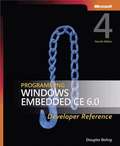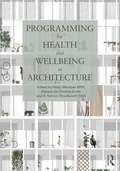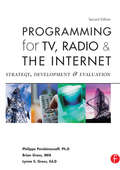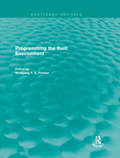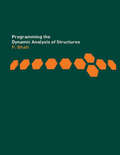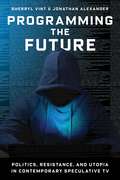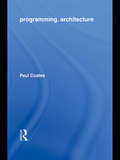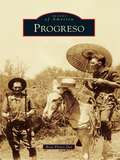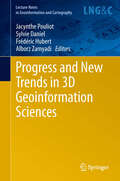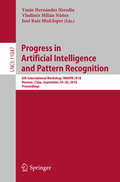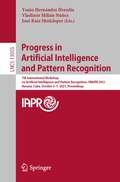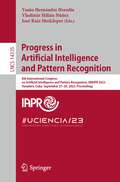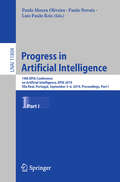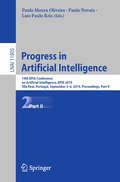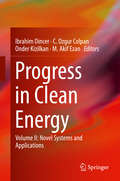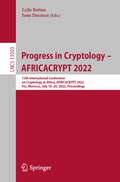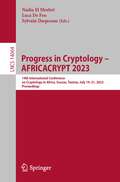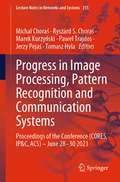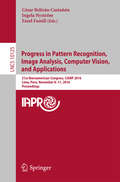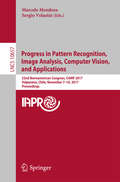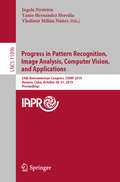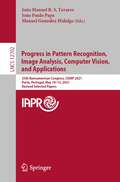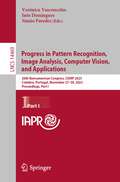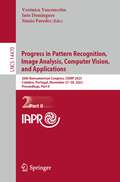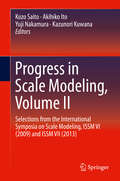- Table View
- List View
Programming Windows® Embedded CE 6.0 Developer Reference
by Douglas BolingGet the popular, practical reference to developing small footprint applications--now updated for the Windows Embedded CE 6.0 kernel. Written by an authority on embedded application development, this book focuses in on core operating concepts and the Win32 API. It delivers extensive code samples and sample projects--helping you build proficiency creating innovative Windows applications for a new generation of devices. Discover how to: Create complex applications designed for the unique requirements of embedded devices Manage virtual memory, heaps, and the stack to minimize your memory footprint Create multithreaded processes and handle events Use the Storage Manager to manage disparate file systems and volumes Store simple groups of data with the database API Read and write registry data, and enumerate keys and values Schedule user, timer event, system event, and bubble notifications Connect to wired and wireless networks, PCs, and other devices Companion Web site includes: Code samples in Microsoft Visual C++ Files for sample projects
Programming for Health and Wellbeing in Architecture
by Keely Menezes MphProgramming for Health and Wellbeing in Architecture presents a new approach to architectural programming that includes sustainability, neuroscience and human factors. This volume of contributions from noted architects and academics makes the case for rethinking the practices of programming and planning to incorporate evidence-based design, systems thinking and a deeper understanding of our evolutionary nature. These 18 original essays highlight how human and environmental health are closely related and should be incorporated as mutually reinforcing goals in every design project. Together, these chapters describe the framework for a new paradigm of building performance and design of the human experience. Programming—the stage at which research is conducted and goals established—provides an opportunity to examine potential impacts and to craft strategies for wellbeing in new buildings and renovations using the latest scientific methods. This book expands the scope of the programming process and provides essential guidance for sustainable practice and the advancement of wellbeing in the built environment for architecture and interiors students, practitioners, instructors and academics.
Programming for TV, Radio & The Internet: Strategy, Development & Evaluation
by Philippe Perebinossoff Lynne Gross Brian GrossWhere do program ideas come from? How are concepts developed into saleable productions? Who do you talk to about getting a show produced? How do you schedule shows on the lineup? What do you do if a series is in trouble? The answers to these questions, and many more, can be found in this comprehensive, in-depth look at the roles and responsibilities of the electronic media programmer. Topics include: Network relationships with affiliates, the expanded market of syndication, sources of programming for stations and networks, research and its role in programming decisions, fundamental appeals to an audience and what qualities are tied to success, outside forces that influence programming, strategies for launching new programs or saving old ones. Includes real-life examples taken from the authors' experiences, and 250+ illustrations!
Programming the Built Environment (Routledge Revivals)
by Wolfgang F. E. PreiserArchitectural programming – the analysis of any given environment to satisfy users’ needs – has become a given prerequisite to the design process. The programming process is often a complicated one: users’ present and future needs must be identified; space allowances, often predetermined, must be considered; equipment must be accommodated; all in the most cost-effective way possible. The variety of user groups is as wide as the variety of functions architecture can shelter; moreover, the different structures and needs of clients that fall within the same use classification differs so greatly that every program presents a new challenge. You cannot, for example, use the same program for every hospital you design. In Programming the Built Environment, first published in 1985, noted architect Wolfgang F. E. Preiser has compiled a wide range of architectural programs demonstrating applications of basic principles for different client groups. This book will be of interest to students of architecture and planning.
Programming the Dynamic Analysis of Structures
by Prab BhattThis book presents a series of integrated computer programs in Fortran-90 for the dynamic analysis of structures, using the finite element method. Two dimensional continuum structures such as walls are covered along with skeletal structures such as rigid jointed frames and plane grids. Response to general dynamic loading of single degree freedom sy
Programming the Future: Politics, Resistance, and Utopia in Contemporary Speculative TV
by Professor Sherryl Vint Professor Jonathan AlexanderFrom 9/11 to COVID-19, the twenty-first century looks increasingly dystopian—and so do its television shows. Long-form science fiction narratives take one step further the fears of today: liberal democracy in crisis, growing economic precarity, the threat of terrorism, and omnipresent corporate control. At the same time, many of these shows attempt to visualize alternatives, using dystopian extrapolations to spotlight the possibility of building a better world.Programming the Future examines how recent speculative television takes on the contradictions of the neoliberal order. Sherryl Vint and Jonathan Alexander consider a range of popular SF narratives of the last two decades, including Battlestar Galactica, Watchmen, Colony, The Man in the High Castle, The Expanse, and Mr. Robot. They argue that science fiction television foregrounds governance as part of explaining the novel institutions and norms of its imagined futures. In so doing, SF shows allegorize and critique contemporary social, political, and economic developments, helping audiences resist the naturalization of the status quo. Vint and Alexander also draw on queer theory to explore the representation of family structures and their relationship to larger social structures. Recasting both dystopian and utopian narratives, Programming the Future shows how depictions of alternative-world political struggles speak to urgent real-world issues of identity, belonging, and social and political change.
Programming.Architecture
by Paul CoatesProgramming.Architecture is a simple and concise introduction to the history of computing and computational design, explaining the basics of algorithmic thinking and the use of the computer as a tool for design and architecture. Paul Coates, a pioneer of CAAD, demonstrates algorithmic thinking through projects and student work collated through his years of teaching students of computing and design. The book takes a detailed and practical look at what the techniques and philosophy of coding entail, and gives the reader many "glimpses under the hood" in the form of code snippets and examples of algorithms. This is essential reading for student and professional architects and designers interested in how the development of computers has influenced the way we think about, and design for, the built environment.
Progreso
by Rosa Flores DeeSpanish for "progress," Progreso is famous for the millions of tourists, known as "Winter Texans," who drive through the town to visit Mexico. Rumor has it that Al Capone did the same thing during Prohibition. Perhaps the first visitor captivated by the Rio Grande was Juan Jose Hinojosa, as he asked the Spanish crown for rights to the land that is now Progreso on July 4, 1776. But it was Florencio Saenz, founder of the iconic Toluca Ranch, who requested a U.S. post office in 1896. Connecting to the Spiderweb Railroad in the 1920s gave the town a short-lived commercial farming boom that attracted prominent investors. In the late 1940s, though, two disastrous freezes killed the citrus industry, and farmers switched to vegetables and cotton. After the Progreso International Bridge was built in 1953, growers gained access to the Mexican market, an advantage that continues to attract people to this small town along the Rio Grande.
Progress and New Trends in 3D Geoinformation Sciences
by Alborz Zamyadi Frédéric Hubert Jacynthe Pouliot Sylvie DanielThe integration of the 3rd dimension in the production of spatial representation is largely recognized as a valuable approach to comprehend our reality, that is 3D. During the last decade developments in 3D Geoinformation (GI) system have made substantial progress. We are about to have a more complete spatial model and understanding of our planet in different scales. Hence, various communities and cities offer 3D landscape and 3D city models as valuable source and instrument for sustainable management of rural and urban resources. Also municipal utilities, real estate companies benefit from recent developments related to 3D applications. In order to present recent developments and to discuss future trends, academics and practitioners met at the 7th International Workshop on 3D Geoinformation. This book comprises a selection of evaluated, high quality papers that were presented at this workshop in May 2012. The topics focus explicitly on the last achievements (methods, algorithms, models, systems) with respect to 3D GeoInformation requirements. The book is aimed at decision makers and experts as well at students interested in the 3D component of geographical information science including GI engineers, computer scientists, photogrammetrists, land surveyors, urban planners, and mapping specialists.
Progress in Artificial Intelligence and Pattern Recognition: 6th International Workshop, IWAIPR 2018, Havana, Cuba, September 24–26, 2018, Proceedings (Lecture Notes in Computer Science #11047)
by Yanio Hernández Heredia Vladimir Milián Núñez José Ruiz ShulcloperThis book constitutes the refereed proceedings of the 6th International Workshop on Artificial Intelligence and Pattern Recognition, IWAIPR 2018, held in Havana, Cuba, in September 2018. The 42 full papers presented were carefully reviewed and selected from 101 submissions. The papers promote and disseminate ongoing research on mathematical methods and computing techniques for artificial intelligence and pattern recognition, in particular in bioinformatics, cognitive and humanoid vision, computer vision, image analysis and intelligent data analysis, as well as their application in a number of diverse areas such as industry, health, robotics, data mining, opinion mining and sentiment analysis, telecommunications, document analysis, and natural language processing and recognition.
Progress in Artificial Intelligence and Pattern Recognition: 7th International Workshop on Artificial Intelligence and Pattern Recognition, IWAIPR 2021, Havana, Cuba, October 5–7, 2021, Proceedings (Lecture Notes in Computer Science #13055)
by Yanio Hernández Heredia Vladimir Milián Núñez José Ruiz ShulcloperThis book constitutes the refereed proceedings of the 7th International Workshop on Artificial Intelligence and Pattern Recognition, IWAIPR 2021, held in Havana, Cuba, in October 2021. The 42 full papers presented were carefully reviewed and selected from 73 submissions. The papers promote and disseminate ongoing research on mathematical methods and computing techniques for artificial intelligence and pattern recognition, in particular in bioinformatics, cognitive and humanoid vision, computer vision, image analysis and intelligent data analysis.
Progress in Artificial Intelligence and Pattern Recognition: 8th International Congress on Artificial Intelligence and Pattern Recognition, IWAIPR 2023, Varadero, Cuba, September 27–29, 2023, Proceedings (Lecture Notes in Computer Science #14335)
by Yanio Hernández Heredia Vladimir Milián Núñez José Ruiz ShulcloperThis book constitutes the refereed proceedings of the 8th International Workshop on Artificial Intelligence and Pattern Recognition, IWAIPR 2023, held in Varadero, Cuba, in October 2023. The 68 papers presented in the proceedings set were carefully reviewed and selected from 38 submissions. The IWAIPR conference aims to provide a leading international forum to promote and disseminate ongoing research into mathematical methods of computing techniques for Artifical Intelligence and Pattern Recognition.
Progress in Artificial Intelligence: 19th EPIA Conference on Artificial Intelligence, EPIA 2019, Vila Real, Portugal, September 3–6, 2019, Proceedings, Part I (Lecture Notes in Computer Science #11804)
by Paulo Novais Luís Paulo Reis Paulo Moura OliveiraThis book constitutes the refereed proceedings of the 19th EPIA Conference on Artificial Intelligence, EPIA 2019, held in Funchal, Madeira, Portugal, in September 2019. The 119 revised full papers and 6 short papers presented were carefully reviewed and selected from a total of 252 submissions. The papers are organized in 18 tracks devoted to the following topics: AIEd - Artificial Intelligence in Education, AI4G - Artificial Intelligence for Games, AIoTA - Artificial Intelligence and IoT in Agriculture, AIL - Artificial Intelligence and Law, AIM - Artificial Intelligence in Medicine, AICPDES - Artificial Intelligence in Cyber-Physical and Distributed Embedded Systems, AIPES - Artificial Intelligence in Power and Energy Systems, AITS - Artificial Intelligence in Transportation Systems, ALEA - Artificial Life and Evolutionary Algorithms, AmIA - Ambient Intelligence and Affective Environments, BAAI - Business Applications of Artificial Intelligence, GAI- General AI, IROBOT - Intelligent Robotics, KDBI - Knowledge Discovery and Business Intelligence, KRR - Knowledge Representation and Reasoning, MASTA - Multi-Agent Systems: Theory and Applications, SSM - Social Simulation and Modelling, TeMA - Text Mining and Applications.
Progress in Artificial Intelligence: 19th EPIA Conference on Artificial Intelligence, EPIA 2019, Vila Real, Portugal, September 3–6, 2019, Proceedings, Part II (Lecture Notes in Computer Science #11805)
by Paulo Novais Luís Paulo Reis Paulo Moura OliveiraThis book constitutes the refereed proceedings of the 19th EPIA Conference on Artificial Intelligence, EPIA 2019, held in Funchal, Madeira, Portugal, in September 2019. The 119 revised full papers and 6 short papers presented were carefully reviewed and selected from a total of 252 submissions. The papers are organized in 18 tracks devoted to the following topics: AIEd - Artificial Intelligence in Education, AI4G - Artificial Intelligence for Games, AIoTA - Artificial Intelligence and IoT in Agriculture, AIL - Artificial Intelligence and Law, AIM - Artificial Intelligence in Medicine, AICPDES - Artificial Intelligence in Cyber-Physical and Distributed Embedded Systems, AIPES - Artificial Intelligence in Power and Energy Systems, AITS - Artificial Intelligence in Transportation Systems, ALEA - Artificial Life and Evolutionary Algorithms, AmIA - Ambient Intelligence and Affective Environments, BAAI - Business Applications of Artificial Intelligence, GAI- General AI, IROBOT - Intelligent Robotics, KDBI - Knowledge Discovery and Business Intelligence, KRR - Knowledge Representation and Reasoning, MASTA - Multi-Agent Systems: Theory and Applications, SSM - Social Simulation and Modelling, TeMA - Text Mining and Applications.
Progress in Clean Energy, Volume 1
by Ibrahim Dincer C. Ozgur Colpan Onder Kizilkan M. Akif EzanThis expansive reference on clean energy technologies focuses on tools for system modelling and analysis, and their role in optimizing designs to achieve greater efficiency, minimize environmental impacts and support sustainable development. Key topics ranging from predicting impacts of on-grid energy storage to environmental impact assessments to advanced exergy analysis techniques are covered. The book includes findings both from experimental investigations and functional extant systems, ranging from microgrid to utility-scale implementations. Engineers, researchers and students will benefit from the broad reach and numerous engineering examples provided.
Progress in Cryptology - AFRICACRYPT 2022: 13th International Conference on Cryptology in Africa, AFRICACRYPT 2022, Fes, Morocco, July 18–20, 2022, Proceedings (Lecture Notes in Computer Science #13503)
by Lejla Batina Joan DaemenThis book constitutes the refereed proceedings of the 13th International Conference on Progress in Cryptology in Africa, AFRICACRYPT 2022, held in Fes, Morocco, from July 18th - 20th, 2022. The 25 papers presented in this book were carefully reviewed and selected from 68 submissions. The papers are organized in topical sections on symmetric cryptography; attribute and identity based encryption; symmetric cryptanalysis; post-quantum cryptography; post-quantum (crypt)analysis; side-channel attacks; protocols and foundations; public key (crypt) analysis.
Progress in Cryptology - AFRICACRYPT 2023: 14th International Conference on Cryptology in Africa, Sousse, Tunisia, July 19–21, 2023, Proceedings (Lecture Notes in Computer Science #14064)
by Sylvain Duquesne Nadia El Mrabet Luca De FeoThis volume contains the papers accepted for presentation at Africacrypt 2023, the 14th International Conference on the Theory and Application of Cryptographic Techniques in Africa. The 21 full papers included in this book were carefully reviewed and selected from 59 submissions. They were organized in topical sections as follows: Post-quantum cryptography; Symmetric cryptography; Cryptanalysis; Blockchain; Lattice-based cryptography; Implementations; Theory.
Progress in Image Processing, Pattern Recognition and Communication Systems: Proceedings of the Conference (CORES, IP&C, ACS) - June 28-30 2021 (Lecture Notes in Networks and Systems #255)
by Ryszard S. Choraś Jerzy Pejaś Marek Kurzyński Tomasz Hyla Michal Choraś Paweł TrajdosThis book presents a collection of high-quality research papers accepted to multi-conference consisting of International Conference on Image Processing and Communications (IP&C 2021), International Conference on Computer Recognition Systems (CORES 2021), International Conference on Advanced Computer Systems (ACS 2021) held jointly in Bydgoszcz, Poland (virtually), in June 2021. The accepted papers address current computer science and computer systems-related technological challenges and solutions, as well as many practical applications and results. The first part of the book deals with advances in pattern recognition and classifiers, the second part is devoted to image processing and computer vision, while the third part addresses practical applications of computer recognition systems. Machine learning solutions for security and networks are tackled in part four of the book, while the last part collects papers on progress in advanced computer systems. We believe this book will be interesting for researchers and practitioners in many fields of computer science and IT applications.
Progress in Pattern Recognition, Image Analysis, Computer Vision, and Applications: 21st Iberoamerican Congress, CIARP 2016, Lima, Peru, November 8–11, 2016, Proceedings (Lecture Notes in Computer Science #10125)
by César Beltrán-Castañón, Ingela Nyström and Fazel FamiliThis book constitutes the refereed post-conference proceedings of the 21st Iberoamerican Congress on Pattern Recognition, CIARP 2016, held in Lima, Peru, in November 2016.The 69 papers presented were carefully reviewed and selected from 131 submissions. The papers feature research results in the areas of pattern recognition, biometrics, image processing, computer vision, speech recognition, and remote sensing. They constitute theoretical as well as applied contributions in many fields related to the main topics of the conference.
Progress in Pattern Recognition, Image Analysis, Computer Vision, and Applications: 22nd Iberoamerican Congress, CIARP 2017, Valparaíso, Chile, November 7–10, 2017, Proceedings (Lecture Notes in Computer Science #10657)
by Marcelo Mendoza Sergio VelastínThis book constitutes the refereed post-conference proceedings of the 22nd Iberoamerican Congress on Pattern Recognition, CIARP 2017, held in Valparaíso, Chile, in November 2017.The 87 papers presented were carefully reviewed and selected from 156 submissions. The papers feature research results in the areas of pattern recognition, image processing, computer vision, multimedia and related fields.
Progress in Pattern Recognition, Image Analysis, Computer Vision, and Applications: 24th Iberoamerican Congress, CIARP 2019, Havana, Cuba, October 28-31, 2019, Proceedings (Lecture Notes in Computer Science #11896)
by Ingela Nyström Yanio Hernández Heredia Vladimir Milián NúñezThis book constitutes the refereed conference proceedings of the 24rd Iberoamerican Congress on Pattern Recognition, CIARP 2019, held in Havana, Cuba, in October 2019. The 70 papers presented were carefully reviewed and selected from 128 submissions. The papers are organized in topical sections named: Data Mining: Natural Language Processing and Text Mining; Image Analysis and Retrieval; Machine Learning and Neural Networks; Mathematical Theory of Pattern Recognition; Pattern Recognition and Applications; Signals Analysis and Processing; Speech Recognition; Video Analysis.
Progress in Pattern Recognition, Image Analysis, Computer Vision, and Applications: 25th Iberoamerican Congress, CIARP 2021, Porto, Portugal, May 10–13, 2021, Revised Selected Papers (Lecture Notes in Computer Science #12702)
by João Manuel R. S. Tavares João Paulo Papa Manuel González HidalgoThis book constitutes the proceedings of the 25th Iberoamerican Congress on Progress in Pattern Recognition, Image Analysis, Computer Vision, and Applications, CIARP 2021, which took place during May 10–13, 2021. The conference was initially planned to take place in Porto, Portugal, but changed to a virtual event due to the COVID-19 pandemic. The 45 papers presented in this volume were carefully reviewed and selected from 82 submissions. They were organized in topical sections as follows: medical applications; natural language processing; metaheuristics; image segmentation; databases; deep learning; explainable artificial intelligence; image processing; machine learning; and computer vision.
Progress in Pattern Recognition, Image Analysis, Computer Vision, and Applications: 26th Iberoamerican Congress, CIARP 2023, Coimbra, Portugal, November 27–30, 2023, Proceedings, Part I (Lecture Notes in Computer Science #14469)
by Inês Domingues Verónica Vasconcelos Simão ParedesThis 2-volume set, LNCS 14469 and 14470, constitutes the proceedings of the 26th Iberoamerican Congress on Progress in Pattern Recognition, Image Analysis, Computer Vision, and Applications, CIARP 2023, which took place in Coimbra, Portugal, in November 2023. The 61 papers presented were carefully reviewed and selected from 106 submissions. And present research in the fields of pattern recognition, artificial intelligence, and related areas.
Progress in Pattern Recognition, Image Analysis, Computer Vision, and Applications: 26th Iberoamerican Congress, CIARP 2023, Coimbra, Portugal, November 27–30, 2023, Proceedings, Part II (Lecture Notes in Computer Science #14470)
by Inês Domingues Verónica Vasconcelos Simão ParedesThis 2-volume set, LNCS 14469 and 14470, constitutes the proceedings of the 26th Iberoamerican Congress on Progress in Pattern Recognition, Image Analysis, Computer Vision, and Applications, CIARP 2023, which took place in Coimbra, Portugal, in November 2023. The 61 papers presented were carefully reviewed and selected from 106 submissions. And present research in the fields of pattern recognition, artificial intelligence, and related areas.
Progress in Scale Modeling, Volume II
by Kozo Saito Akihiko Ito Yuji Nakamura Kazunori KuwanaThis volume thoroughly covers scale modeling and serves as the definitive source of information on scale modeling as a powerful simplifying and clarifying tool used by scientists and engineers across many disciplines. The bookelucidates techniques used when it would be too expensive, or too difficult, to test a system of interest in the field. Topics addressed in the current edition include scale modeling to study weather systems, diffusion of pollution in air or water, chemical process in 3-D turbulent flow, multiphase combustion, flame propagation, biological systems, behavior of materials at nano- and micro-scales, and many more. This is an ideal book for students, both graduate and undergraduate, as well as engineers and scientists interested in the latest developments in scale modeling. This book also: Enables readers to evaluate essential and salient aspects of profoundly complex systems, mechanisms, and phenomena at scale Offers engineers and designers a new point of view, liberating creative and innovative ideas and solutions Serves the widest range of readers across the engineering disciplines and in science and medicine
